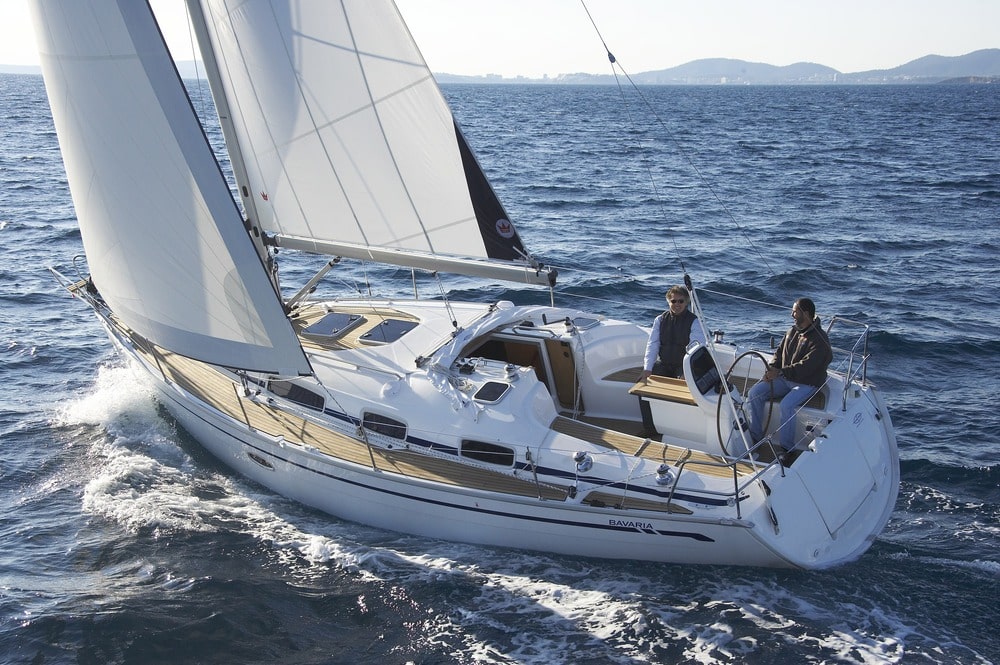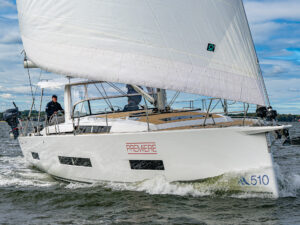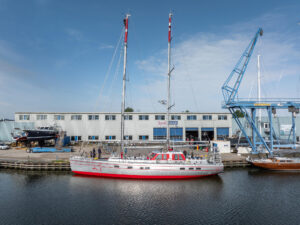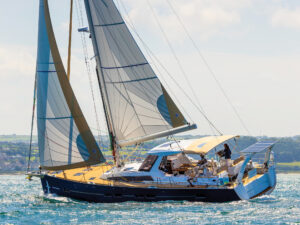
Of all the high-output production sailboat builders in Europe, Bavaria Yachts is located farthest from the sea. Interestingly, distance hasn’t separated the company’s design office from the realities that the sea imposes on boats and those that sail them.
On the Bavaria 38 Cruiser, this is most apparent belowdecks. Half a step from the foot of the companionway, robust furniture is close at hand. To port, it’s the sturdy fiddles on the galley counter; to starboard, the nav desk. They provide secure handholds to someone descending the companionway in a seaway. Other offshore-friendly features below include a forward-facing nav desk that’s large enough to take paper charts, saloon settees that are parallel to the centerline and long enough to stretch out on, and corner cut-out grabs in the partial bulkheads at the galley and nav desk. The finish (high-gloss varnished pale mahogany) will take on a more classic appearance once time and the natural light that pours in through numerous hatches and portlights have darkened it a little.
In the two-stateroom layout, the forward cabin occupies the entire space forward of the mast. It has a large V-berth, lots of storage lockers, and a good bit of walkabout room. In both the two- and three-cabin layouts, the aft cabin(s) have generous standing room and a large berth.
The single head in the two-cabin layout is aft, behind the nav station. If it appears unusually spacious, maybe that’s because we’ve become accustomed to boats this size having more than one. The head is smaller and takes up a good chunk of the forward cabin in the three-cabin arrangement.
No matter what navigation practices you follow, a functional nav station still provides a key central location for instruments and a useful flat work surface. The 38’s nav desk serves the purpose adequately, with several storage compartments, a dedicated area for mounting instruments, and a dished seat for a little butt traction when the boat heels. The electrical panel is of a new generation, with touch-pad switches that light up when a circuit is activated but they don’t respond with the reassuring on/off clunk of a circuit breaker. The breakers are mounted behind the panel.
Given the elbow room everywhere else, it seems that the galley was last in line when volume was being assigned and a three-burner stove would allow more culinary options than the two-burner model installed. Still, the galley is functional, has a nice corner for wedging into at sea, and is well furnished with stowage space and the obligatory, it seems, microwave oven. The twin sinks are artful in that their bottoms slope toward their drains, which are inboard, but they’d be more practical if they were a bit deeper.
A peek under the floorboards reveals a structural grid that’s laminated to the hull. The space below the floor is deep enough to create a shallow bilge, but the hull’s flat bottom could make completely drying it a challenge. The keel bolts are installed through the grid and secured with double nuts backed by stainless-steel washers.
The cockpit of this boat is comfortable and workable. The table mounted on the steering console is an expected accessory, but while it’s convenient for many activities, its bulk hampers freedom of movement during sailing maneuvers a bit.
Forward, the seat backs have the right geometry to give support where needed, but they lose it as they get shorter going aft. In the Gee-Whiz Department, electric rams tucked under the cockpit sole aft of the wheel open up the center section of the transom to reveal a swim step and ladder. At the other end of the cockpit, a low bridgedeck and, atop it, a low sill will help keep green water from getting belowdecks. The companionway door may look a bit light weight, but it’s made of veneer-topped Starboard.
A flush hatch in the foredeck opens to reveal a deep anchor well with a windlass mounted on a shelf. The brochure for the boat shows the anchor mounted on a short projection off the bow, but the boat we tested had no such arrangement. The anchor was snugged right back to the stem, and its shank was four chain links from the wildcat on the windlass.
The 38 is available with an in-mast furling main (as on our test boat) or a main with either conventional or full-length battens. The deck is also sufficiently reinforced to accept a wide range of options, such as a double-ended mainsheet system that brings both tails back to the helmsman. The roller-furling jib, adjustable backstay, and six winches are standard.
The wind took a vacation on the day of our test sail, so all we can report is that when the wind gusted up to about 4.5 knots, the boat made about 2.7 knots when closehauled.
A couple of years ago, Bavaria adopted the tandem keel for its shoal-draft option, and this has become the standard keel offered on North American imports. Patented by Warwick Collins, the tandem keel can reportedly impart greater controllability than conventional shoal-draft keels.
In the absence of wind, conditions were ideal for measuring speed under power. At its maximum 2,800 rpm, the 40-horsepower Volvo with saildrive pushed the boat at 7.8 knots; a much-quieter 2,000 rpm delivered a shade under 6.5 knots. When the wheel was put hard over, the boat turned in one boat length. Behavior when backing was commendable.
The Bavaria 38 should appeal to those looking for a sailboat to take out sailing, not a weekend apartment furnished in the current vogue. Certain design decisions appear to have been made to favor sailing characteristics over a few more cubic feet of living space. The 38 is less beamy, and the beam draws in a bit more toward the stern than some of its contemporaries. As a sailboat, it’s handsomely styled, it appears to function well, and it has most of the equipment and amenities (and many more are available as options) needed to make sailing and living aboard a rewarding experience. The bottom line is that the 38 Cruiser is a production boat, which makes it a starting point from which to build a personal yacht.
Jeremy McGeary is a CW contributing editor.
LOA 38′ 6″ (11.75 m.)
LWL 32′ 6″ (9.91 m.)
Beam 12′ 10″ (3.91 m.)
Draft 5′ 3″ (1.60 m.)
Sail Area 745 sq. ft. (69.2 sq. m.)
Ballast 4,629 lb. (2,100 kg.)
Displacement 15,840 lb. (7,184 kg.)
Ballast/D .29
D/L 206
SA/D 18.9
Water 95 gal. (360 l.)
Fuel 40 gal. (152 l.)
Mast Height 50′ 8″ (15.44 m.)
Engine 40-hp. Volvo with saildrive
Designer J&J Design
Price $203,500
Bavaria Yachts
(410) 990-0007
www.bavariayachts.com








